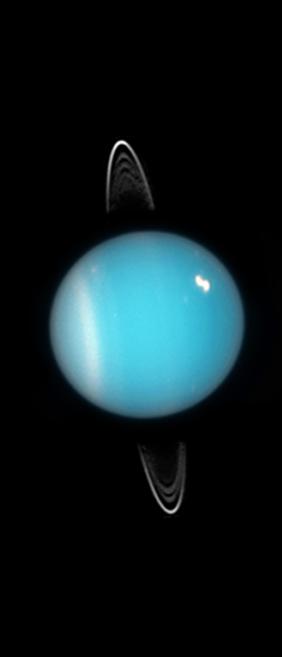Glossarbegriffe: Uranus
Description: Uranus ist von der Sonne aus gesehen der siebte Planet im Sonnensystem. Er ist ein Eisriese mit einem Radius von etwa 25.000 Kilometern (km), was ungefähr dem vierfachen Erdradius entspricht. Die Masse des Uranus beträgt das 14,5-fache der Masse der Erde. Der Uranus hat einen festen Gesteinskern, der von einer Schicht aus Wasser, Methan und Ammoniak unter hohem Druck umgeben ist. Im frühen äußeren Sonnensystem waren diese Stoffe gefroren. Der junge Uranus sammelte diese "Eise" auf, daher die Bezeichnung "Eisriese". Die äußere Atmosphäre des Uranus besteht aus einer dicken Schicht aus Wasserstoff und Helium. Seine Rotationsachse ist um mehr als 90 Grad gegenüber seiner Bahnebene geneigt. Uranus hat ein Ringsystem.
Seine mittlere Entfernung von der Sonne beträgt etwa 2,9 Milliarden km. Das sind rund 19 Astronomische Einheiten (Abstand Erde-Sonne, kurz AE). Uranus braucht etwa 84 Jahre für einen Umlauf um die Sonne. Er hat über 25 bekannte Monde oder natürliche Satelliten.
Uranus ist selbst unter guten Bedingungen mit dem bloßen Auge kaum sichtbar und wurde daher vor der Neuzeit nicht als Planet erkannt. Er wurde erst 1781 von William Herschel als Planet ausgemacht. Damit war er der erste Planet, der seit der Antike entdeckt wurde. Uranus ist nach dem griechischen Gott des Himmels benannt.
Zugehörige Glossarbegriffe:
- Astronomische Einheit
- Riesenplanet
- Eisriese
- Monde
- Neptun
- Äußere Planeten
- Planetenring
- Sonnensystem
- Rotation
See this term in other languages
Term and definition status: The original definition of this term in English have been approved by a research astronomer and a teacher The translation of this term and its definition is still awaiting approval
The OAE Multilingual Glossary is a project of the IAU Office of Astronomy for Education (OAE) in collaboration with the IAU Office of Astronomy Outreach (OAO). The terms and definitions were chosen, written and reviewed by a collective effort from the OAE, the OAE Centers and Nodes, the OAE National Astronomy Education Coordinators (NAECs) and other volunteers. You can find a full list of credits here. All glossary terms and their definitions are released under a Creative Commons CC BY-4.0 license and should be credited to "IAU OAE".
Zugehörige Medien
Uranus in natural colours
Bildnachweis: NASA/JPL-Caltech credit link
License: PD Public Domain icons
Uranus with rings
Bildnachweis: NASA, ESA, and M. Showalter (SETI Institute) credit link
License: PD Public Domain icons










